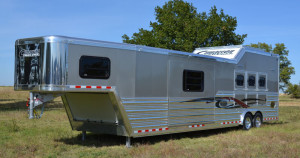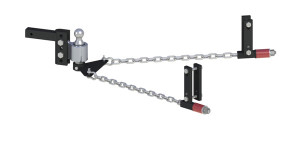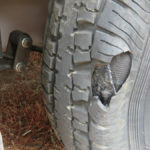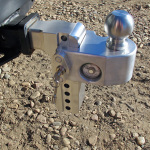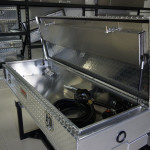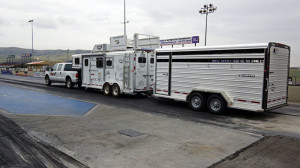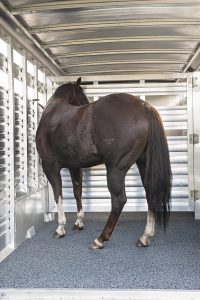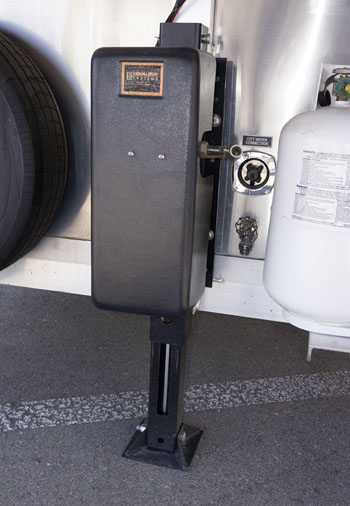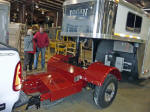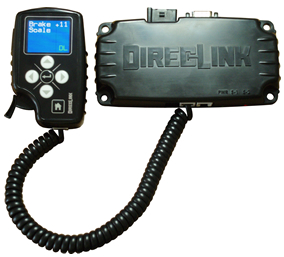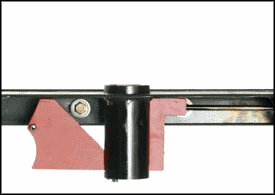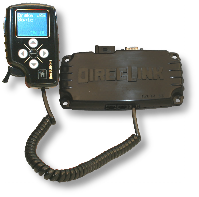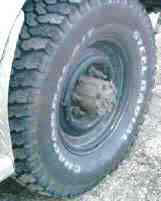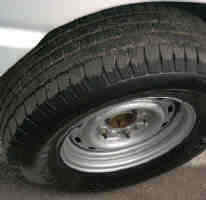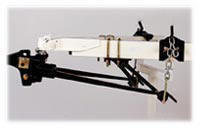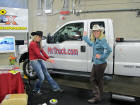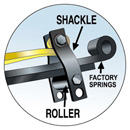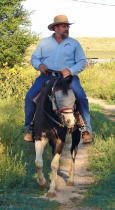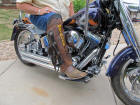MrTruck’s Web Wisdom of Truck Safety.
We all want a truck to go 300,000 miles and we think we’ll live forever. When I sold trucks, I was surprised at how many folks had accidents in their trucks and unhurt, they came back to me to buy another truck! Trucks are safer than cars, don’t let anybody fool you. I’m looking for ways and products to keep trucks and trailers safer. On this page you will see what I find. Is your hitch rated for your trailer to pull your truck? MrTruck’s Web Wisdom of Truck Safety.

MrTruck’s Web Wisdom of Truck Safety. Trailering accident.
NHTSA Check out the latest safety issues the government monitors.
New Trailer Safety brochure from NHTSA: Click here to order yours.
 How safe are you? I think about this every time I jack up my truck and hesitate to use the jack stands and block the tires. I know folks that have been crushed to death by their vehicles. Kind of like safety belts, it only takes one short cut to safety to end your world. How safe are you? I think about this every time I jack up my truck and hesitate to use the jack stands and block the tires. I know folks that have been crushed to death by their vehicles. Kind of like safety belts, it only takes one short cut to safety to end your world. |
|
DRIVER DROWSINESS STUDY USING FORD VIRTTEX SIMULATOR COMES TO AN END
DEARBORN, Mich., Feb. 26 – Ford is testing technology to combat the deadly problem of drowsy driving by having drivers literally fall asleep at the wheel. It’s all completely safe – utilizing Ford’s state-of-the-art VIRTTEX driving simulator. The study began in October. By the time it comes to an end in March, more than 30 drivers will have taken part in the study into driver drowsiness and accident avoidance. The findings will be analyzed and announced later in the spring. VIRTTEX stands for VIRtual Test Track EXperiment. Ford is the only North American automaker with a full-motion-based driving simulator like VIRTTEX. The research findings will be used to develop new safety technology, slated to debut first on Volvo vehicles, known as the world’s safety leader – and then possibly later on other Ford Motor Company brands. A Deadly Problem According to U.S. National Highway Traffic Safety Administration (NHTSA) estimates, drowsiness accounts for about four percent of all fatal crashes – more than 1,500 deaths each year. It is a major cause of catastrophic accident and injury. It is estimated that approximately 100,000 police-reported crashes annually – about 1.5 percent of all crashes – involve drowsiness and fatigue as a principal causal factor. “These are often not minor accidents when they occur,” said Greenberg. “When someone falls asleep at the wheel, the vehicle often leaves the lane and the roadway – followed by a major crash or rollover. Our goal is to better understand these incidents and investigate whether new technologies could be developed that might detect this situation and help prevent it from happening.” Ford and Volvo researchers are investigating ways to sense when a driver is falling asleep and beginning to veer out of the vehicle’s lane. After ascertaining that in fact the driver is falling asleep, the team is testing technology to help prevent that unintended lane departure. There are several concepts being studied for effectiveness when the vehicle systems sense the driver falling asleep: The simulated vibration and sound of running over a rumble strip is broadcast. Red lights flash. And the wheel is forcibly turned to keep the vehicle from swerving out of its lane. Planning the Tests In September, a Ford Taurus, which had starred in an earlier breakthrough driver distraction study, was moved out of the VIRTTEX test chamber, and a Volvo S80 was moved in. The piece of technology most visible to the driver is the addition of a high-resolution camera on the center console pointed at the drivers face. It is meant to monitor the eyes and eye movement. A computer calculates the percentage of eye closed versus eye open – to sense if the driver is falling asleep. “Our intent is to make sure this system, when developed, works right,” said Greenberg. “There is nothing more annoying to a driver than false signals – false beeps, buzzes and vibration – when the driver is not falling asleep. False signals would could nag the driver to the point he or she just turns it off. And a system that is turned off is not serving any purpose whatsoever.” When Ford researchers were confident that the test procedures and machinery were designed right – it was time to hire the test subjects. Selecting the Subjects More than 300 potential test subjects were interviewed with a detailed 15-page questionnaire. Researchers were looking for a varied group of men and women that represented likely Volvo customers in terms of income and vehicle desire. More than 30 men and women were selected, ranging in ages from 21 to 70. They are asked to stay up all night, the night before the test, and take no caffeine after six p.m. that preceding evening. A sensor placed on a watchstrap is worn the day before the test to verify that the test subject does not fall asleep. Performing the Tests Some participants were unable to complete the test, falling asleep and then being unable to awaken sufficiently to complete the exercise. Others completed the drive route without incident. Most participants were somewhere in between — dozing off and being awakened, often several times. New Safety Features May Result Feb. 25, 03 |
|
||||
|
FORD MOTOR COMPANY PROMOTES SAFE TEEN DRIVING CAMPAIGN AMONG THOUSANDS OF DEALERS NATIONWIDE
LAS VEGAS, Nev., Jan. 31, 2004 – Ford Motor Company’s North American dealers got a lesson in safe driving today at the National Automobile Dealers Association convention as they participated in a clinic to educate dealers on ways to promote safe driving for teenagers in their communities. Traffic accidents are the number-one killer of teens in America and Ford Motor Company has joined forces with the Governors Highway Safety Association (GHSA) and the National Highway Traffic Safety Administration (NHTSA) to deliver a multi-year, educational campaign called Real World Driver: Driving Skills for Life to high school students nationwide. The Real World Driver program includes a teacher’s guide, video and other materials that have been distributed to every public high school in the country. In addition to these materials, there is also an interactive web site –www.realworlddriver.com – that gives students and parents more information about driving skills and provides visitors the opportunity to take a quiz online for a chance to win exciting prizes. “Unfortunately, car crashes remain the number one killer of teens,” Susan Cischke, Ford Motor Company Vice President, Environmental and Safety Engineering told the dealers at the NADA briefing. “Yet most of the crashes and resulting injuries and deaths could be prevented if teenagers better understood the necessary skills for safely driving motor vehicles and protected themselves by wearing their safety belt. Real World Driver has been designed to illustrate for young drivers safe driving techniques in key areas that safety experts say are of particular importance to novice drivers.” According to data from NHTSA, more than 6,000 teens die each year from injuries resulting from car crashes – making car crashes the number one killer of teens in America. Yet a national survey by Wirthlin Worldwide shows that many people underestimate the challenges novice drivers face. When asked, 56 percent of Americans named drug abuse as the leading health threat teenagers face, with only 13 percent identifying teen driving crashes as the number one threat. Four Critical Driving Skills To design the Real World Driver program, Ford and GHSA convened a distinguished panel of safety experts that included representatives from NHTSA, the International Association of Chiefs of Police Highway Safety Committee and Students Against Destructive Decisions (SADD). According to the Real World Driver Advisory Board, the four key driving skills young drivers should master are: hazard recognition, vehicle handling, space management and speed management.
“Our Advisory Board identified specific items, like left turns, that can turn deadly for teens due to their lack of awareness and experience in those areas,” Cischke said. “Real World Driver’s goal is to turn these four areas into four ‘driving skills for life’ by focusing on the skills that are most likely to prevent crashes and save teens’ lives. But awareness is only part of the solution. There is no substitute for behind-the-wheel training and practice.” Graduated Licensing and Extended Education Ford partnered with GHSA, which represents state highway safety offices, to ensure that Real World Driver is promoted in states and local communities. “We’re excited to partner with Ford on this program and hope it will help states raise awareness of the teen driving issue as they work to strengthen their graduated driver’s licensing laws,” said GHSA Board Member and Director of the Nevada Office of Traffic Safety Charles Abbott. “We are also optimistic that Real World Driver will encourage teens to get more actual driving time with a focus on specific driving skills.” Ford, GHSA and other safety experts agree that the sensible way for teens to learn driving is to phase them into it. Most states now have graduated driver’s licensing (GDL) laws that do just that – restrict driving in risky times and under risky circumstances until responsible performance is demonstrated over a period of time. Ford and GHSA support graduated driving laws, and hope Real World Driver will help augment them by offering guidance to parents and teens on what skills should be learned and practiced. Wirthlin’s research also indicated that just 11 percent of parents and 12 percent of all adults are satisfied with the training resources available to first-time drivers. Moreover, nearly all parents (94 percent) are concerned about their teens driving independently. “Real World Driver is a youth-friendly, comprehensive tool for young drivers to use as an enhancement to their driver education,” said Ashley Conners, SADD 2002-2003 Student of the Year and former SADD President at Foothill High School in Las Vegas. “It is great to see companies and organizations using teenagers to make a difference in the attitudes and knowledge of their peers.” Buckle Up While hands-on, behind-the-wheel training and educational materials are important elements of any safe driving program, Cischke reminds all drivers that safety belts continue to provide the single, most effective protection in any vehicle crash. “Parents should insist that their teenagers buckle up,” Cischke said. “The safety belt is the single best way to avoid getting hurt in a crash.” Dealers who would like to obtain more information about the program and how they can assist in partnership with the Ford Motor Company and Governors Highway Safety Association can log onto the official website — www.realworlddriver.com. |
IIHS Front Crash “Best Picks”
- 2004 F-150 is a “best pick” in IIHS frontal crash test; the first pickup truck to receive this honor
DEARBORN, Mich., Dec. 19, 2003 – The all-new 2004 Ford F-150 pickup truck and the new Ford Freestar and Mercury Monterey minivans received “good” rankings and were named “best picks” in the most recent round of high-speed frontal offset crash testing performed by the Insurance Institute for Highway Safety (IIHS) – the institute’s highest possible rating.
The F-150 is the first, and only, pickup truck to receive a “best pick” in the high-speed frontal offset crash category.
DaimlerChrysler Video Offers Teen Driving Tips with video game.
There’s a new tool for anxious parents teaching their teenagers how to drive — a DaimlerChrysler AG-sponsored video game where kids earn points by avoiding driving hazards. DaimlerChrysler hopes the Road Ready Streetwise game will help prepare teens for driving before they actually get behind the wheel. At a news conference, Chrysler Group president and CEO Dieter Zetsche said the game will raise awareness about all kinds of hazards new drivers face. “We set out to build a more pragmatic way to help parents prepare their teens for safe driving,” Zetsche said. “Video games are a better way.” Teens can download the game for free on the Web(www.roadreadyteens.org). Players progress through six levels, working through driving challenges like deflecting questions from other teens in the car, answering a ringing cell phone and eating. Meanwhile, the driver must avoid trucks backing into their lanes, swerving drunk drivers, skateboarders and even a UFO. Jeffrey Runge, chief of the National Highway Traffic Safety Administration, said the game would help teens guard against traffic accidents. Road fatalities are the leading cause of death for Americans under the age of 34. (Source: The Detroit News)
FORD LAUNCHES CAMPAIGN TO HELP TEENS HONE THEIR DRIVING SKILLS
(Dearborn, MI) — According to data from the National Highway Traffic Safety Administration (NHTSA), more than 6,000 teens die each year from injuries resulting from car crashes – making it the number one killer of teens in America. Yet, a recent national survey by Wirthlin Worldwide shows that many people underestimate the challenges novice drivers face. When asked, 56 percent of Americans named drug abuse as the leading health threat teenagers face, with only 13 percent identifying teen driving crashes as the number one threat.
ENJOYTHEDRIVE.COM SUGGESTS WAYS TO SAVE MONEY AT THE GAS PUMP
SEMA’s Consumer Web Site Offers Seven Tips to Help Any Vehicle Get Better Fuel Economy DIAMOND BAR, Calif. (March 13, 2003)–As gas prices rev up, enjoythedrive.com suggests several ways drivers can save money at the gas pump.
“Everybody has become uncomfortably aware of their vehicles’ fuel economy,” says Chris Horn, vice president of communications for SEMA, the Specialty Equipment Market Association. “While you can save money by driving fewer miles, that isn’t an option for most of us. Fortunately, it’s easy for practically any vehicle to get better gas mileage. And there’s a bonus: Many modifications that enhance fuel economy also improve your vehicle’s performance, and they reduce emissions.”
|
FORD MOTOR COMPANY AND THE GOVERNORS HIGHWAY SAFETY ASSOCIATION TEACH TEENS CRITICAL SKILLS NEEDED TO BECOME SAFER DRIVERS
Real World Driver Program Promotes Top 4 Safe Driving Skills; Materials Reach Every Public High School in the Country(Dearborn, MI) – As millions of teenagers head back to school this month, the Ford Motor Company and the Governors Highway Safety Association are focusing on the issue of safe teen driving by promoting their Real World Driver: Driving Skills for Life program to principals of every public high school in the country (20,000).According to the National Highway Traffic Safety Administration (NHTSA), more than 6,000 teens die each year from injuries resulting from car crashes – making it the number one killer of teens in America.
|
- Driver distraction study finds teenagers to be as much as 56 percent more distracted than adults when operating a cellular phone while driving.
- The retrieval of voicemail using hands-free technology does not significantly distract drivers.
Death Rate Lowest for Occupants of SUVs
While they’re more prone to roll over during accidents than cars, newer
sport-utility vehicles now have a lower overall death rate, according to
a study by an insurance industry research group. But the statistics also
support a frequent criticism of SUVs: Their size and weight cause
mismatches in collisions with smaller vehicles, and those occupants are
more likely to be killed or injured… An analysis of 2001 traffic deaths
by the Insurance Institute shows the death rate in SUVs fell to 115
fatalities per million registered vehicles, the lowest among all types
of passenger vehicles. That was down from 134 fatalities per million in
2000 and from 494 per million in 1980, when SUVs accounted for twice the number of fatalities as cars. (Source: Chicago Tribune)
After I spent a couple of weeks driving GM Quadrasteers and enjoying the stability with a trailer and on snowy icy roads, I dawned on me that part of the equation was the wider rear track of the Quadrasteer. A normal GM HD 2500 4×4 has the same rear axle as a 4×2 for obvious economic reasons. So the 4×4 rear axle is 2 inches narrower than the front. But the Quadrasteer rear axle is over 3 inches wider than the front. So I remembered reading about Correctrack rear-wheel alignment system. Now I’m testing the spacers. There are several makes of trucks and vans that have this tracking deficit. Read my conclusions, click for more..
MrTruck’s Web Wisdom of Truck Safety
Centramatic wheel balancers can take the vibration out of the steering wheel. It’s hard to keep a tire balanced on the rough roads that a lot of trucks live on. So just after a few months of driving, your tires don’t feel new anymore. Enjoy the safety of improved, less stressful steering with automatic balancing. Read more….

|
Static electricity can build up from the plastic bedliner rubbing on the metal truck bed. Pouring gasoline from a gas container sitting in the truck bed into a lawn mower, ATV etc. or filling a gas container sitting in the truck bed sitting on top of a plastic drop-in bedliner can cause a fire. Always take the portable gas container out of the truck bed before filling it or using it to fill other gas tanks. Click on the blue links for more articles: |
Car Crashes the Leading Cause of Death for Teens
I grew up in the country, driving on dirt roads. I discovered later how important that was to know the difference between pavement and gravel driving. On dirt roads the shoulders are soft and if you get too close, it will suck you into the ditch. Which is exactly what you do, you slow down and drive right into the ditch at the same angle. So many people try to turn hard away from the ditch and roll their vehicle. The gravel windrows that run parallel with the roads will also create challenges with steering. Were I grew up, car crashes on dirt roads were the leading cause of death for teenagers as they are today. Usually it evolves someone not familiar with the driving characteristics of dirt roads and alcohol. The statistics I’ve read also show only 20% of the accidents happen in rural areas, but 60% of the fatalities happen there. If you survive the accident, it takes longer to get help. The below article deals with the other driving dangers for teenagers. Learn all you can, show your kids what driving on dirt roads is like and lets have safe holidays.
CARFAX Announces Safe Car – Safe Teen Driver Program To Protect America’s Teens
September 2002 (Newstream) — Motor vehicle crashes are the leading cause of death for teenagers, resulting in thousands of deaths nationwide per year. In fact, teenagers are involved in three times as many fatal crashes as other drivers, according to The National Highway Traffic Safety Administration.
For Judy Appleby and Bob Moore, these are more than statistics. Each lost their teen in crashes. However, many experts believe accidents like the ones that took the lives of Michael Appleby and Cassie Moore can be prevented if parents and teenagers sit down together to learn and practice safe-driving techniques. Experts say teenagers are more prone to accidents because of their inexperience behind the wheel, their risk-taking behavior and immaturity.
To keep teen drivers safe on the road, CARFAX – a company that can check the history of any used car – is launching the Safe Car – Safe Teen Driver Campaign.
It features an interactive Web site designed to make parents and teens aware of risks and safety measures for young drivers to help reduce the number of teenagers involved in fatal or disabling automobile crashes. Another component of the program is an email drive designed to reach the millions of parents who have or will have teens at the driving age in their household.
Parents and teens can access the site at www.carfax.com/teen.
Produced for Carfax Inc. CONTACT: Julie Atlas, 703-934-2664
MrTruck’s Web Wisdom of Truck Safety
SPECIAL FOR THE READERS OF MR. TRUCK
|
|

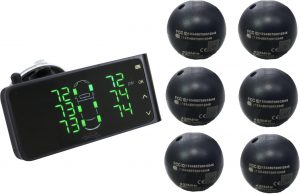





 Drop-in plastic bedliners in trucks can build up static electricity and turn a portable gas container into a bomb!
Drop-in plastic bedliners in trucks can build up static electricity and turn a portable gas container into a bomb!










